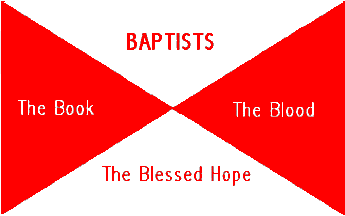
| Home |
What We Believe |
Our Purpose |
Contact Us |
Pages By Topic |
Pages By Title |
EARNESTLY CONTENDING FOR THE FAITH:
BAPTIST HISTORY:
THE TRAIL OF BLOOD CHART
By J. M. Carroll

|
THE LORD JESUS CHRIST IS GOD MANIFEST IN THE FLESH. THAT IS WHY HE IS GOD. |
|
Do you know for a fact that if you were
to die today that you would not go to hell? If you do not know, click here. |
 |
 |
 |

CLICK HERE FOR A FULL SIZE IMAGE OF THIS CHART
| I believe, if you will study carefully
this chart, you will better understand the history, and it will
greatly aid your memory in retaining what you hear and see. Remember this chart is supposed to cover a period of two thousand years of religious history. Notice at both top and bottom of the chart some figures, the same figures at both top and bottom - 100, 200, 300, and so on to 2,000. They represent the twenty centuries of time--the vertical lines separating the different centuries. Now notice on the chart, near the bottom; other straight lines, this line running left to right, the long way of the chart. The lines are about the same distance apart as the vertical lines. But you can't see them all the way. They are covered by a very dark spot, representing in history what is known as the "dark ages." It will be explained later. Between the two lowest lines are the names of countries . . . Italy, Wales, England, Spain, France, and so forth, ending with America. These are names of countries in which much history is made during the period covered by the names themselves. Of course not all the history, some history is made in some of the countries in every period. But some special history is made in these special countries, at these special periods. Now notice again, near the bottom of the chart, other lines a little higher. They, too, covered in part by the "dark ages," they also are full of names, but not names of countries. They are all "nick-names." Names given to those people by their enemies. "Christians"--that is the first: "The disciples were called Christians first at Antioch" (Acts 11:26). This occurred about A.D. 43. Either the pagans or Jews gave them that name in derision. All the other names in that column were given in the same manner--Montanists, Novationists, Donatists, Paulicians, Albigenses, Waldenses, etc., and Ana-Baptists. All of these will again and again be referred to as the lectures progress. But look again at the chart. See the red circles. They are scattered nearly all over the chart. They represent churches. Single individual churches in Asia, in Africa, in Europe, in mountains and valleys, and so forth. Their being blood red indicates martyr blood. Christ their founder died on the Cross. All the Apostles save two, John and Judas, suffered martyr deaths. Judas betrayed his Lord and died in a suicide. The Apostle John, according to history, was boiled in a great cauldron of oil. You will note some circles that are solidly black. They represent churches also. But erring churches. Churches that had gone wrong in life or doctrine. There were numbers of these even before the death of Peter, Paul and John. Having now about concluded with a general introduction and some very necessary and even vital preliminaries, I come to the regular history-- |
| Back To Top |
Back To Main Baptist History Page |
Back To Home Page |
